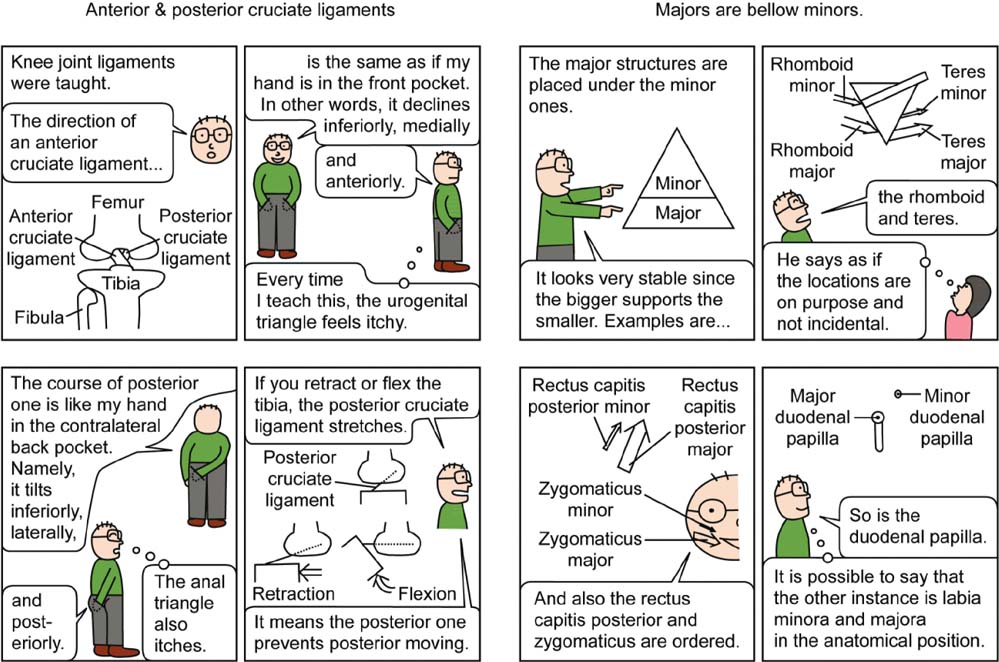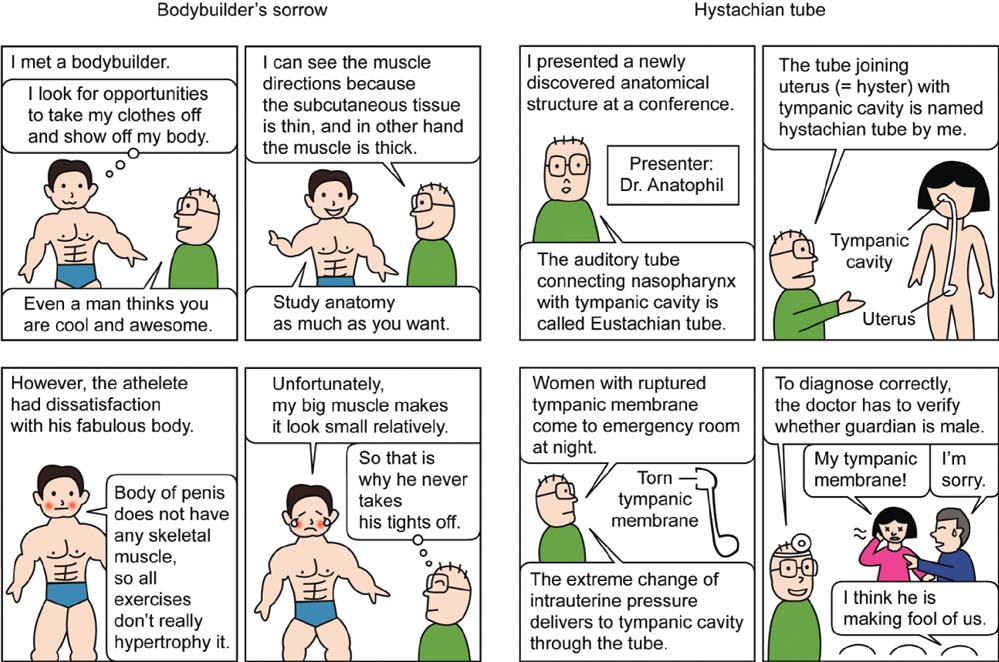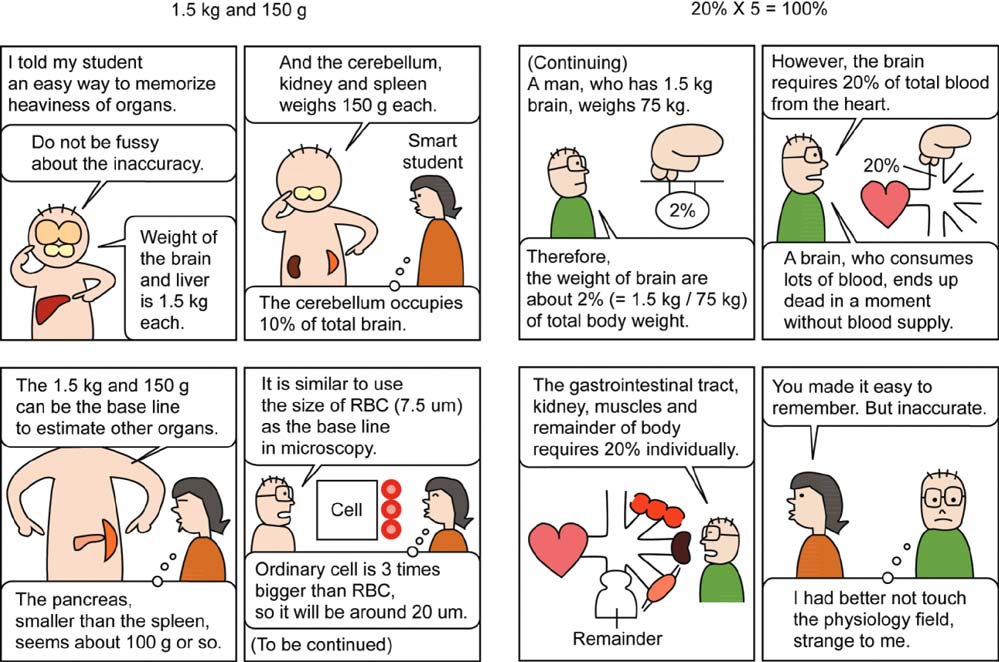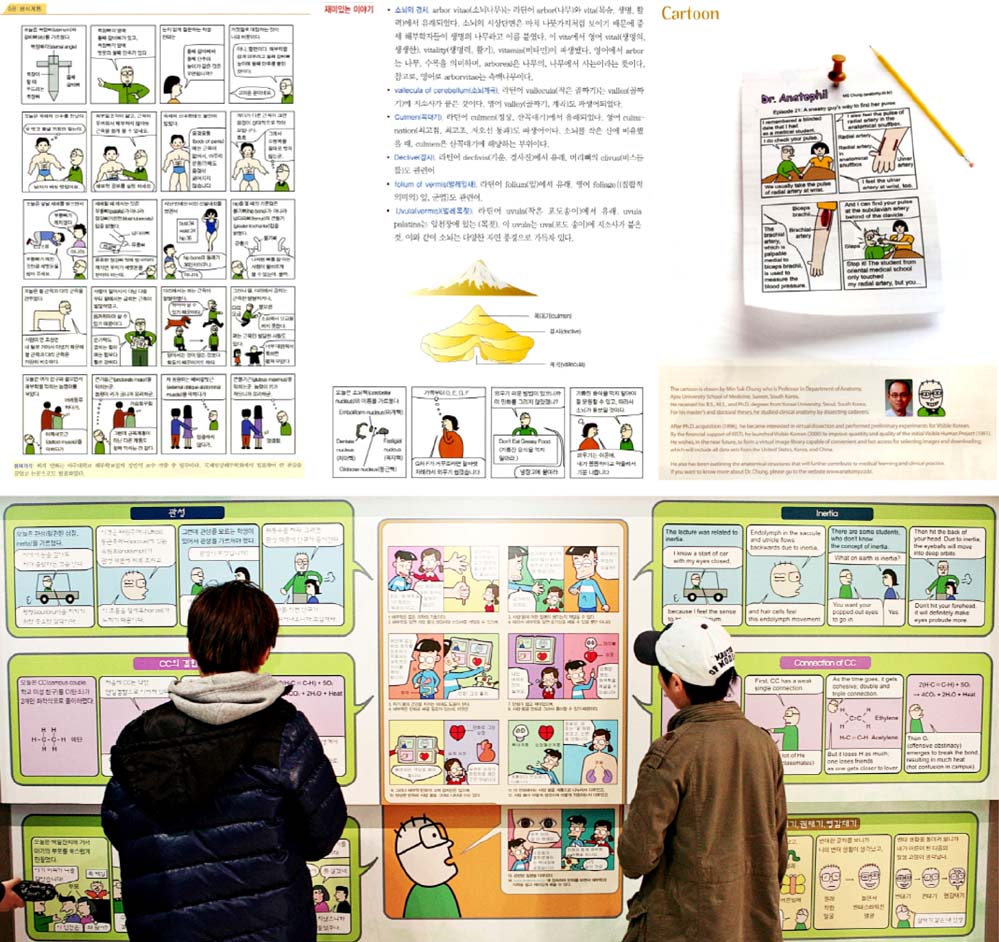Anat Cell Biol.
2013 Sep;46(3):210-216. 10.5115/acb.2013.46.3.210.
Evaluation of anatomy comic strips for further production and applications
- Affiliations
-
- 1Department of Anatomy, Ajou University School of Medicine, Suwon, Korea. dissect@ajou.ac.kr
- 2Department of Anatomy, Dongguk University College of Medicine, Gyeongju, Korea.
- 3Graduate School of Information and Communication, Ajou University, Suwon, Korea.
- KMID: 2263148
- DOI: http://doi.org/10.5115/acb.2013.46.3.210
Abstract
- The corresponding author of the study has been sketching comic strips to explain anatomy in a humorous manner. All the anatomy comic strips, including those in Korean (650 episodes) and English (451 episodes), can be viewed on the homepage (http://anatomy.co.kr). Such comic strips were created with the aim of assisting medical students. However, their impact was unknown, and therefore, we surveyed the students' responses. We noted that anatomy grades were better in the students who read the comic strips. The comics helped the trainees chat with individuals with and without a medical background. The authors also considered comments on the problems with the comic strips and attempted to find solutions. The episodes are being currently used and further produced for educational purposes. To support this effort, the readers' valuable opinions will be continuously collected and assessed.
Keyword
Figure
Cited by 1 articles
-
Homepage to distribute the anatomy learning contents including Visible Korean products, comics, and books
Beom Sun Chung, Min Suk Chung
Anat Cell Biol. 2018;51(1):7-13. doi: 10.5115/acb.2018.51.1.7.
Reference
-
1. Park JS, Kim DH, Chung MS. Anatomy comic strips. Anat Sci Educ. 2011; 4:275–279.2. McDermott TJ. Cartooning: a humorous approach to medical and health education. J Biocommun. 1989; 16:20–27.3. Pease RA. Cartoon humor in nursing education. Nurs Outlook. 1991; 39:262–267.4. Weitkamp E, Burnet F. The Chemedian brings laughter to the chemistry classroom. Int J Sci Educ. 2007; 29:1911–1929.5. Olson JC. The comic strip as a medium for promoting science literacy [Internet]. Northridge, CA: California State University;cited 2013 Sep 16. Available from: http://www.csun.edu/~jco69120/coursework/697/projects/OlsonActionResearchFinal.pdf.6. Green MJ, Myers KR. Graphic medicine: use of comics in medical education and patient care. BMJ. 2010; 340:c863.7. McCloud S. Understanding comics: the invisible art. New York: Harper Perennial;2004.8. O'Luanaigh C. Graphic medicine: How and why medical practitioners and patients are using comics in medical communication [dissertation]. London: Imperial College London;2010.9. Tatalovic M. Science comics as tools for science education and communication: a brief, exploratory study. J Sci Commun. 2009; 8:A02.10. Medikidz. Medical information for kids [Internet]. London: Medikidz;cited 2013 Sep 16. Available from: http://www.medikidz.com.11. Kim DH, Jang HG, Shin DS, Kim SJ, Yoo CY, Chung MS. Science comic strips. J Educ Learn. 2012; 1:65–71.12. Chung MS. Anatomy comic strips. Seoul: Hanmi Medical Publishing Co.;2013.13. Goldberg S, Ouellette H. Clinical anatomy made ridiculously simple. 4th ed. Miami: MedMaster, Inc.;2010.14. Chung IH. Abstracted human anatomy. 2nd ed. Seoul: Hyunmoon;2012. p. 308.15. Park JS, Shin DS, Rhyu IJ, Lee KM, Chung MS, Chi JG, Hwang SJ. Essential neuroanatomy. Seoul: Hanmi Medical Publishing Co.;2012. p. 45. p. 57. p. 72. p. 83. p. 93. p. 113. p. 114. p. 121. p. 122. p. 135. p. 147.
- Full Text Links
- Actions
-
Cited
- CITED
-
- Close
- Share
- Similar articles
-
- Manufacture of the Animations on Health Information
- Homepage to distribute the anatomy learning contents including Visible Korean products, comics, and books
- Anatomy Cartoon for Common People
- Development of Comic Books and an Animation as Dietary Education Materials for Children
- Effects of Reading a Free Electronic Book on Regional Anatomy with Schematics and Mnemonics on Student Learning





